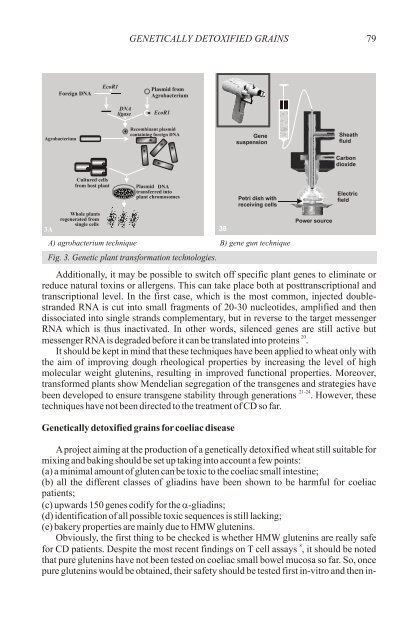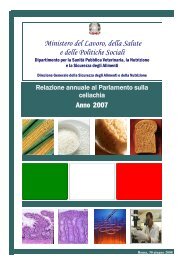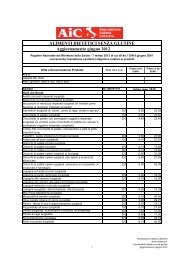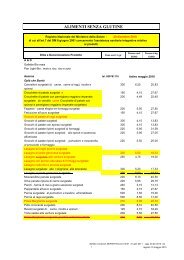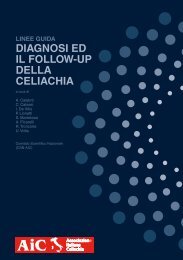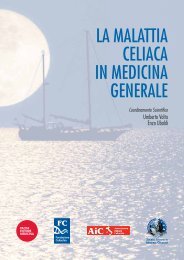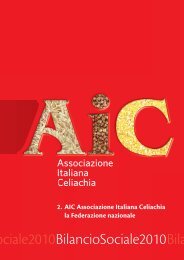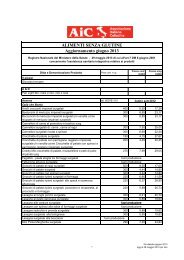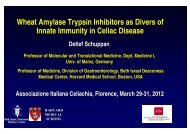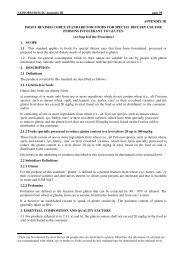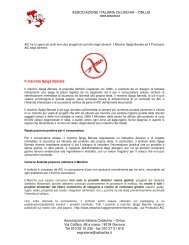primary prevention of coeliac disease - Associazione Italiana ...
primary prevention of coeliac disease - Associazione Italiana ...
primary prevention of coeliac disease - Associazione Italiana ...
You also want an ePaper? Increase the reach of your titles
YUMPU automatically turns print PDFs into web optimized ePapers that Google loves.
•<br />
•<br />
GENETICALLY DETOXIFIED GRAINS<br />
79<br />
Foreign DNA<br />
EcoR1<br />
DNA<br />
ligase<br />
Plasmid from<br />
Agrobacterium<br />
EcoR1<br />
Agrobacterium<br />
Recombinant plasmid<br />
containing foreign DNA<br />
•<br />
•<br />
Gene<br />
suspension<br />
Sheath<br />
fluid<br />
•<br />
Carbon<br />
dioxide<br />
3A<br />
Cultured cells<br />
from host plant<br />
Whole plants<br />
regenerated from<br />
single cells<br />
Plasmid DNA<br />
transferred into<br />
plant chromosomes<br />
A) agrobacterium technique B) gene gun technique<br />
Fig. 3. Genetic plant transformation technologies.<br />
Additionally, it may be possible to switch <strong>of</strong>f specific plant genes to eliminate or<br />
reduce natural toxins or allergens. This can take place both at posttranscriptional and<br />
transcriptional level. In the first case, which is the most common, injected doublestranded<br />
RNA is cut into small fragments <strong>of</strong> 20-30 nucleotides, amplified and then<br />
dissociated into single strands complementary, but in reverse to the target messenger<br />
RNA which is thus inactivated. In other words, silenced genes are still active but<br />
20<br />
messenger RNA is degraded before it can be translated into proteins .<br />
It should be kept in mind that these techniques have been applied to wheat only with<br />
the aim <strong>of</strong> improving dough rheological properties by increasing the level <strong>of</strong> high<br />
molecular weight glutenins, resulting in improved functional properties. Moreover,<br />
transformed plants show Mendelian segregation <strong>of</strong> the transgenes and strategies have<br />
21-24<br />
been developed to ensure transgene stability through generations . However, these<br />
techniques have not been directed to the treatment <strong>of</strong> CD so far.<br />
Genetically detoxified grains for <strong>coeliac</strong> <strong>disease</strong><br />
Petri dish with<br />
receiving cells<br />
Power source<br />
Electric<br />
field<br />
A project aiming at the production <strong>of</strong> a genetically detoxified wheat still suitable for<br />
mixing and baking should be set up taking into account a few points:<br />
(a) a minimal amount <strong>of</strong> gluten can be toxic to the <strong>coeliac</strong> small intestine;<br />
(b) all the different classes <strong>of</strong> gliadins have been shown to be harmful for <strong>coeliac</strong><br />
patients;<br />
(c) upwards 150 genes codify for the a-gliadins;<br />
(d) identification <strong>of</strong> all possible toxic sequences is still lacking;<br />
(e) bakery properties are mainly due to HMW glutenins.<br />
Obviously, the first thing to be checked is whether HMW glutenins are really safe<br />
8<br />
for CD patients. Despite the most recent findings on T cell assays , it should be noted<br />
that pure glutenins have not been tested on <strong>coeliac</strong> small bowel mucosa so far. So, once<br />
pure glutenins would be obtained, their safety should be tested first in-vitro and then in-<br />
3B


